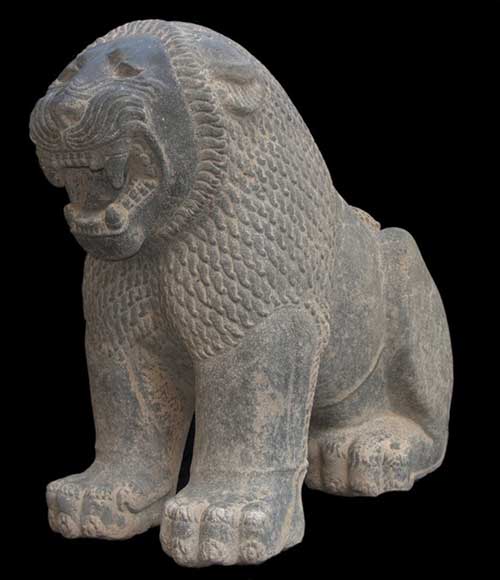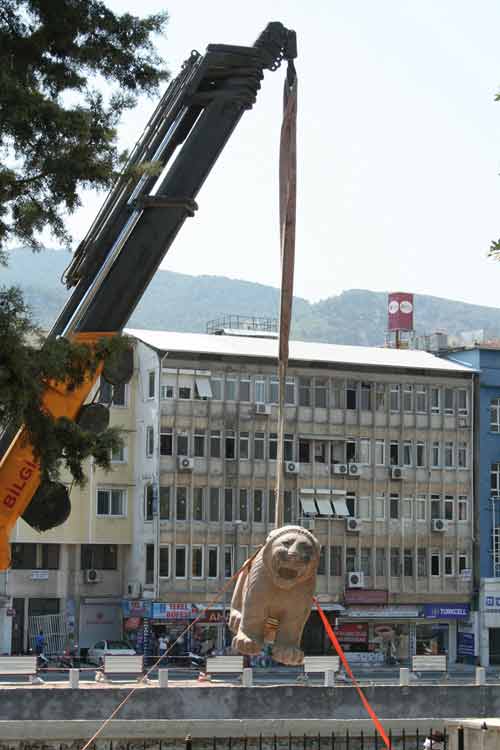
 Sculpture News at SculptSite.com
Sculpture News at SculptSite.com
University of Toronto archaeologists - Lion Sculpture |
| LiveScience by Jennifer Welsh Stone Lion Reveals Sophisticated Ancient CultureThe stone lion sculpture that adorned the Tayinat citadel gate was uncovered in southeastern Turkey by University of Toronto archaeologists.The discovery of a 3,000-year-old stone lion guarding a gate complex in southeastern Turkey suggests the people of the Neo-Hittite Kingdom of Patina were more culturally advanced than previously believed. The gate appears to have provided access to the citadel of Kunulua, the capital of Patina, between 950 B.C. and 725 B.C. (The site is also sometimes called Kinaula, and the city-state Palistin.) The lion uncovered at Tayinat citadel gate in southeastern Turkey by University of Toronto archaeologists is being transported to the Antakya Archaeological Museum. CREDIT: Lynn Welton View full size imageThe lion, which is about 4 feet (1.3 meters) tall and 5 feet (1.6 m) wide, is "fully intact," study researcher Timothy Harrison, of the University of Toronto in Canada, said in a statement. "It is poised in a seated position, with ears back, claws extended and roaring." "A second piece found nearby depicts a human figure flanked by lions, which is an iconic Near Eastern cultural motif known as the Master and Animals. It symbolizes the imposition of civilized order over the chaotic forces of the natural world," Harrison said. During this time, the eastern Mediterranean was just emerging from the Bronze Age and entering the Iron Age. These animal statues "continued a Bronze Age Hittite tradition that accentuated their symbolic role as boundary zones, and the role of the king as the divinely appointed guardian, or gatekeeper, of the community," Harrison said. The site indicates that some of the cultural traditions of the Bronze Age carried over, even as the Assyrians took control of the city. The gate seems to have been destroyed in 738 B.C. when the area was paved over and converted into the central courtyard of a sacred Assyrian precinct. The dig is part of the Tayinat Archeological Project in southeastern Turkey. A very similar lion-carved column was discovered in the 1930s at the entrance to an Assyrian temple on the same site. It's possible that the Assyrians reused lion statues from elsewhere on the site. Either way, this new evidence indicates that the statues weren't a product of the Assyrian culture, as researchers had thought, but existed in the area before occupation. The finding has yet to be published, and the researchers are continuing to excavate the site. |
 Here we go again! Time + Sculpture = Society or is it Time + Society = Sculpture... Whatever it is, it's sure exciting that the University of Toronto archaeologists unearthed this sculpture from around 8th Century B.C. - that is a whole lot of years! Kudos to them all for their hard work. It's just so, so fascinating... |
 |
| The stone lion sculpture that adorned the Tayinat citadel gate was uncovered in southeastern Turkey by University of Toronto archaeologists. CREDIT: Jennifer Jackson |
 |
| The lion uncovered at Tayinat citadel gate in southeastern Turkey by University of Toronto archaeologists is being transported to the Antakya Archaeological Museum. CREDIT: Lynn Welton |
More Sculpture News ....
Submit your SCULPTURE NEWS.
It's easy, just send us an e-mail
(click on Submit News in the left menu) with your pertinent information along with images, we'll take care of the rest. Sculpture makes our world a much better place in so many ways!
SculptSite.com, along with Sculptors and their creative genius all helping to bring the beauty and message of Sculpture to a hurried world.

